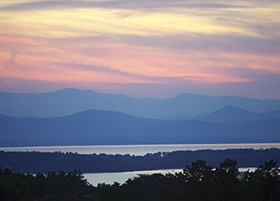
Local, national and global environmental and public health protection is a key societal concern. Our current research on environmental and public health strives to limit the damage to the natural environment and ecosystem, and potentially avoid exposure of humans and natural systems to hazards.
Research Project: Biofouling Mechanisms of Surface-modified Ultrafiltration Membranes During Wastewater Treatment

PI: Huijie Lu (Civil and Environmental Engineering, UVM)
Co-PI: Raju Badireddy (Civil and Environmental Engineering, UVM)
Students involved: Mengfei Li
Description: The recently developed bismuth dimercaptopropanol nanoparticles (BisBAL NP) are capable of outperforming commercially available antibiotics such as chlorhexidine, nystatin, and terbinafine in biofilm control. BisBAL NPs also appear to be more effective than other nanoparticles (e.g., silver NPs) in enhancing antifouling capacities of ultrafiltration membranes, mainly due to their lower minimal inhibitory concentrations (MIC) for typical biofouling microorganisms. This study aimed at examining the microbial ecology of biofouling processes occurring on both commercial ultrafiltration membranes (not surface modified), and the novel, BisBAL NP-modified membranes. By depicting a more comprehensive and detailed picture of the biofouling mechanisms, this study can potentially inspire more efficient anti-fouling strategies for membrane-based wastewater treatment.
Publications:
Badireddy, A., et al. (2014). "Synthesis and characterization of lipophilic bismuth dimercaptopropanol nanoparticles and their effects on oral microorganisms growth and biofilm formation." Journal of Nanoparticle Research 16(6): 1-12.
Tailpipe Emissions from Light-Duty Engines Operating on Alternative Fuels: Is Biodiesel Really Better?
PI: Britt A. Holmén
Co-PI: Naomi K. Fukagawa
Graduate Students Involved: John Kasumba (Ph.D.), Tyler Feralio (Ph.D.) , Jim Dunshee (M.S.)
Description: Depleting fossil fuel reserves, energy security and climate change concerns have increased use of biomass-based fuels worldwide, but little is known about the ultrafine and nanoparticles and gas-phase air toxics emitted when operating on biodiesel fuel blends. Using a Volkswagen light-duty diesel engine that operates on a transient drive cycle, we measure tailpipe exhaust and engine parameters at 1Hz resolution to answer the following questions in this interdisciplinary research collaboration:
How does particle- and gas-phase exhaust composition change with engine operating parameters and biodiesel fuel blend?
Are the health effects of biodiesel better or worse than for petroleum diesel?
Are biodiesel particles more or less reactive to ozone and are the oxidation products more or less likely to increase particle toxicity?
How does exhaust particle size and organic chemical composition vary among blends of two biodiesel fuels (soybean and recycled cooking oil)?
Example Research Presentations
Dunshee, Jim and Britt A. Holmén (2014) Measured and Modeled Biodiesel Exhaust from Diesel Vehicles: A MOVES2010b Evaluation. Paper 8CO.1, American Association for Aerosol Research 33nd Annual Conference, October 20-24, Orlando, FL.
Feralio, Tyler and Britt A. Holmén (2014) Effect of Drive Cycle and Fuel Type on Ultrafine Particle Number Emissions Model Input Optimization. 93rd Annual Meeting of the Transportation Research Board, January 2014, Washington, DC. Paper No. 14-4588.
PDF FILE CAN BE MADE AVAILABLE
Feralio, Tyler and Britt A. Holmén (2014) Light-Duty Diesel Biodiesel Particle Number Emissions Relative to Blend Ratio and Engine Conditions, Paper 8CO.7, American Association for Aerosol Research 33nd Annual Conference, October 20-24, Orlando, FL.
Kasumba, John and Britt A. Holmén (2014) Oxidation of Biodiesel Exhaust Particulate Matter with Ozone. Paper 2AC.7, American Association for Aerosol Research 33nd Annual Conference, October 20-24, Orlando, FL.
Publications:
Fukagawa, Naomi K., Muyao Li, Matthew E. Poynter, Brian C. Palmer, Erin Parker, John Kasumba and Britt A. Holmén (2013) Soy Biodiesel and Petrodiesel Emissions Differ in Size, Chemical Composition and Stimulation of Inflammatory Responses in Cells and Animals. Environmental Science & Technology 47 (21), 12496–12504. 10.1021/es403146c
Contaminant Transport in Building Materials

PI: Mandar Dewoolkar (Civil and Environmental Engineering, UVM)
Co-PI: Donna Rizzo and Nancy Hayden
Graduate Students Involved: Cabot Savidge, David Grover and Lucas Howard
Description: We are studying contaminant transport through porous building materials. We are using techniques such as X-ray tomography, surface permeability mapping and fluorescent confocal microscopy to quantify geomorphic structures of building materials such as sandstone, limestone, concrete and brick. A numerical model is being calibrated using the above data and physical transport experiments. This study supports an overarching goal of understanding fate and transport of chemical agents in porous materials used in heritage and essential facilities, so appropriate decontamination strategies could be developed. This research has been funded by the Los Alamos National Laboratory and Defense Threat Reduction Agency.
Publications:
Hu, L., Savidge, C., Rizzo, D., Hayden, N. Hagadorn, W., and Dewoolkar, M. (2013), “Commonly used porous building materials: geomorphic pore structure and fluid transport”, Journal of Materials in Civil Engineering, 25(12), 1803-1812.
Savidge, C. R., Hu, L. B., Hayden, N. J., Rizzo, D., and Dewoolkar, M. M. (2008), “Variability in surface permeability of porous building substrates and their implications on transport of agents”, Chemical and Biological Defense Physical Science and Technology Conference, New Orleans, LA, November. (Oral presentation)
Hu, L. B., Savidge, C. R., Brownell, M., Hayden, N. J., Rizzo, D., and Dewoolkar, M. M. (2008), “Prediction of agent transport in porous building materials”, Chemical and Biological Defense Physical Science and Technology Conference, New Orleans, LA, November. (Oral presentation)
Research Project: Contaminant Transport in Building Materials
PIs: Mandar Dewoolkar, Donna Rizzo and Nancy Hayden
Graduate Students Involved: Cabot Savidge and David Grover
Undergraduate Students Involved: Odanis Rosario and Laura Townsend
Description: This study supported an overarching goal of understanding fate and transport of chemical agents in porous materials used in heritage and essential facilities, so appropriate decontamination strategies could be developed. The study is also relevant to building contamination from fires and environmental pollution, which continues to be a serious and expensive problem rendering buildings unusable for long periods of time. This research has been funded by the Los Alamos National Laboratory, Defense Threat Reduction Agency and Defense Science and Technology Laboratory (U.K.).
Publications:
Grover, D., Savidge, C. R., Townsend, L., Rosario, O., Hu, L.-B., Rizzo, D. M., and Dewoolkar, M. M. (2016), "Surface permeability of natural and engineered porous building materials", Construction and Building Materials, 112, 1088-1100, http://www.sciencedirect.com/science/article/pii/S0950061816302525.
Hu, L., Savidge, C., Rizzo, D., Hayden, N. Hagadorn, W., and Dewoolkar, M., "Commonly used porous building materials - geomorphic pore structure and fluid transport", Journal of Materials in Civil Engineering, 25(12), http://ascelibrary.org/doi/abs/10.1061/%28ASCE%29MT.1943-5533.0000706.
Savidge, C. R., Hu., L. B., Hayden, N. J., Rizzo, D., and Dewoolkar, M. M. (2008), "Variability in surface permeability of porous building substrates and their implications on transport of agents", Chemical and Biological Defense Physical Science and Technology Conference, New Orleans, November.
Hu, L. B., Savidge, C. R., Brownell, M., Hayden. N. J., Rizzo, D., and Dewoolkar, M. M. (2008), "Prediction of agent transport in porous building materials", Chemical and Biological Defense Physcial Science and Technology Conference, New Orleans, LA, November.
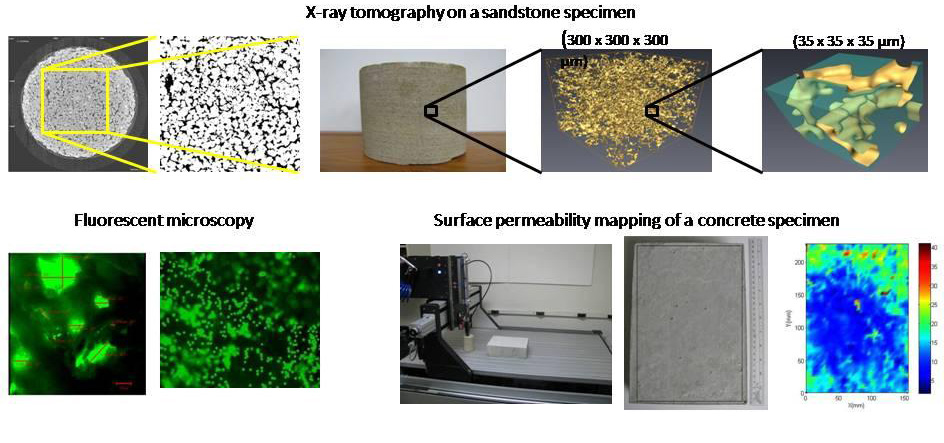
Research Project: Streambank Erosion, Sediment Transport, Impacts on Water Bodies
PIs: Mandar Dewoolkar, Donna Rizzo and Paul Bierman
Graduate Students Involved: Jaron Borg, Kristen Underwood and Scott Hamshaw
Undergraduate Students Involved: None
Description: Streambank erosion is recognized as one of the most important nonpoint sources of sediment and phosphorus entering streams, rivers, and lakes, and thus one of the largest contributors to the impairment of surface water quality and aquatic habitat. We combined many concepts of soil mechanics and geology to gain fundamental understanding of the mechanics of riverbank instability and the source of sediments in streams contributing to increasing phosphorus levels in Lake Champlain. Using in-situ and laboratory testing of streambank soils, determining soil erodibility, continuous remote monitoring of embedded instrumentation, and transient flow and slope stability modeling, we are learning what makes some banks stable and other banks fail over both time and changing river and groundwater conditions. Additionally, a sediment fingerprinting study is being conducted to understand where the sediments come from. We have also employed terrestrial LiDAR and Unmanned Aerial Systems to quantify streambank movements at site-specific and river corridor scales. Large quantity of data are also being collected on total suspended sediment, turbidity, and other indicators of pollutants. The funding sources have included Vermont Water Resources & Lake Studies Center, VT NSF EPSCoR's Research on Adaptation to Climate Change grant and Basin Resilience to Extreme Events grant.
Publications:
Hamshaw, S. D., Bryce, T., Rizzo, D. M., O'Neil-Dunne, J., Frolik, J., and Dewoolkar, M. M. (2017), "Quantifying streambank movement and topography using unmanned aircraft system photogrammetry with comparsion to terrestrial laser scanning," River Research and Applications, DOI: 10.1002/rra.3183.
Hamshaw, S. D., Bryce, T., O’Neil Dunne, J., Rizzo, D. M., Frolik, J., Engel, T., and Dewoolkar, M. M., “Quantifying streambank erosion using unmanned aerial systems at the site-specific and river network scales,” GeoCongress 2017.
Borg, J., Dewoolkar, M. M., and Bierman, P. (2014), "Assessment of streambank stability - a case study," Geo-Congress 2014, pp. 1007-1016.
Underwood, K. L., C. Alves, D. S. Ross, M.M. Dewoolkar and D.M. Rizzo (2016), “Influence of Geomorphic Setting on Distribution of Nutrient Stocks in Lake Champlain basin Floodplains”, The Geological Society of America,
Northeast Secion – 51st Annual Meeting, T7. Interaction between the Landscape and Aquatic Biogeochemistry, Abstract# 272354, March 21-23, 2016, Accepted 2015.
Hamshaw, S.D., Underwood, K.L., Rizzo, D.M., O’Neil, J., and Dewoolkar, M. M. (2015), “Quantifying streambank erosion: a comparative study using an unmanned aerial system (UAS) and a terrestrial laser scanner”, EOS Transactions, American Geophysical Union, NH43C-1913, Abstract ID # 85568, Fall Meeting, San Francisco, CA, December.
Hamshaw, S.D., Underwood, K.L., Dewoolkar, M.M. and Rizzo, D.M. (2015), “Sediment Loading and Sources in the Mad River Implication s for Sediment-bound Nutrient Management” IAGLR (International Association for Great Lakes Research), 58th Annual Conference, Burlington VT, May 25-29.
Hamshaw, S. D., Rizzo, D. M., Underwood, K. L., Wemple, B. C., & Dewoolkar, M. (2014). Suspended Sediment Prediction Using Artificial Neural Networks and Local Hydrometeorological Data. Poster presented at the 2014 NEAEB Conference, Burlington, VT.
Hamshaw, S. D., Rizzo, D. M., Underwood, K. L., Wemple, B. C., & Dewoolkar, M. (2014). High Frequency Turbidity Monitoring to Quantify Sediment Loading in the Mad River. Presented at the 2014 NEAEB Conference, Burlington, VT.
Rizzo, D.M., Hamshaw, S.D., Anderson, H., Underwood, K.L., and Dewoolkar, M.M. (2013), “Estimates of Sediment Loading from Streambank Erosion Using Terrestrial LIDAR sediment in rivers using artificial neural networks: Implications for development of sediment budgets”, EOS Transactions, American Geophysical Union, Abstract H13D-1353, Fall Meeting, San Francisco, CA, December.
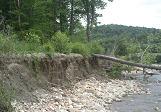
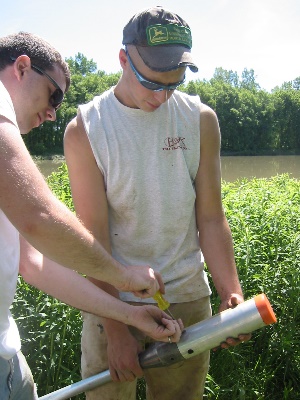
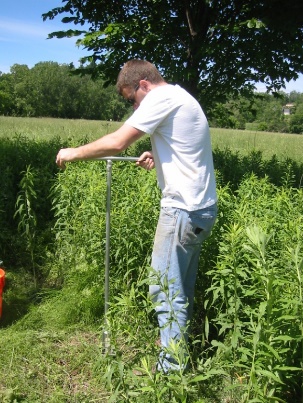
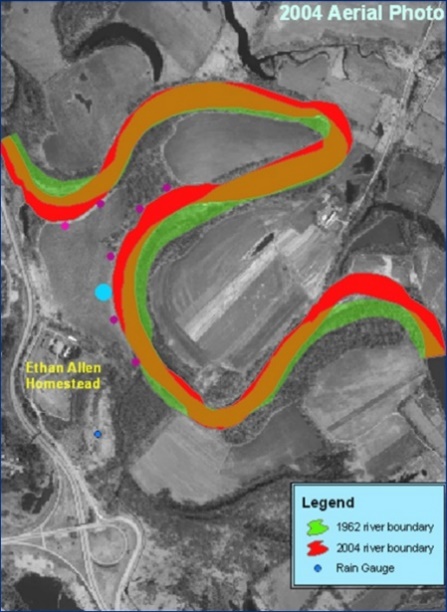
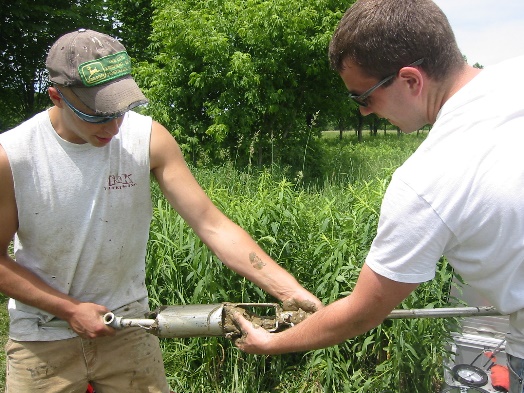
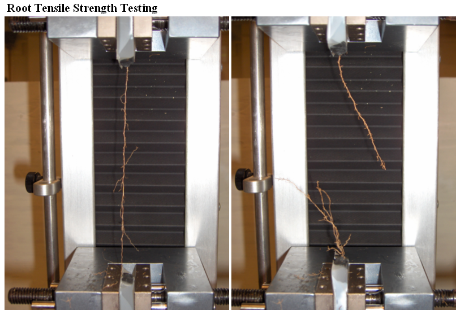
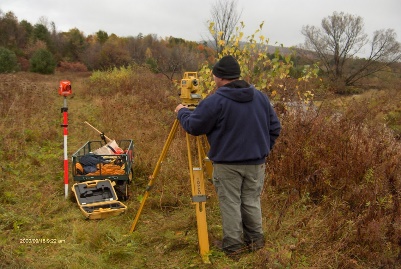

Research: Production of beneficial products from organic wastes
PI: Matthew Scarborough (Civil and Environmental Engineering, UVM)
Graduate Students Involved: Panagiota Stamatopoulou, Leandro Conrado, Amy DeCola, Kennedy Brown
Undergraduate Students Involved: Olivia Mead, Juliet Malkowski, Ryan McKeown, Kristina Harmon
Description: Organic wastes are an abundant byproduct of human activity. There is strong interest in directing organic wastes, including food and yard wastes, away from landfills. This project explores the production of beneficial products from organic wastes, including fuels and valuable chemicals. Projects under this theme include producing medium-chain carboxylic acids with anaerobic microbiomes, controlling anaerobic digestion processes to optimize biogas production, and managing residuals of anaerobic biorefining (e.g., nutrients, microplastics). Research under this theme spans fundamental science at the molecular level to systems-level applied research with Vermont industrial partners.
Publications:
Stamatopoulou, P., Malkowski, J., Conrado, L., Brown, K. & Scarborough, M. Fermentation of Organic Residues to Beneficial Chemicals: A Review of Medium-Chain Fatty Acid Production. Processes 8, doi:10.3390/pr8121571 (2020).
Scarborough, M. J., Lawson, C. E., DeCola, A. C. & Gois, I. M. Microbiomes for sustainable biomanufacturing. Curr Opin Microbiol 65, 8-14, doi:10.1016/j.mib.2021.09.015 (2022).
